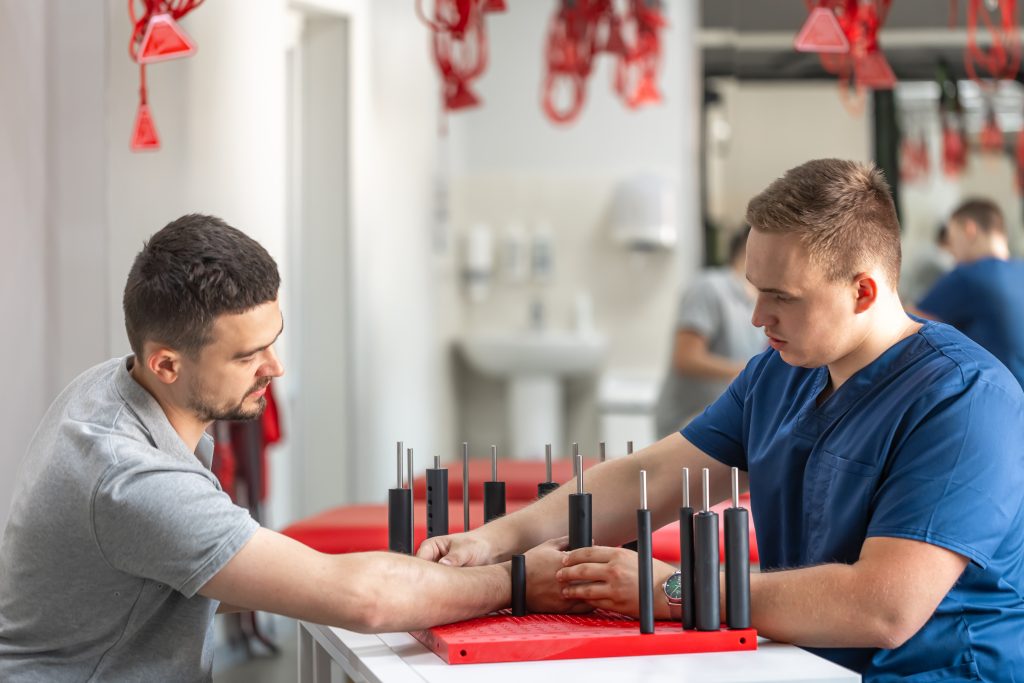What is Wrist replacement?
Wrist replacement, also known as wrist arthroplasty, is a surgical procedure that involves replacing the radiocarpal joint, connecting the hand to the arm. This surgery aims to alleviate pain and improve the range of motion in individuals with wrist injuries or arthritis. On average, a newly replaced wrist joint can last for approximately 10 to 15 years.

When is it required
Wrist replacement surgery is commonly done to treat wrist arthritis and the associated pain. It is typically used for patients with Inflammatory-type arthritis. Arthritis causes the degradation of the smooth cartilage that covers the ends of bones, allowing pain-free and frictionless joint movement. When this cartilage is lost due to arthritis, the bone ends become exposed and rough, leading to discomfort and limited mobility.
What happens before Wrist Replacement?
It is essential to have a skilled orthopaedic surgeon, particularly one who specializes in hand surgery, to conduct wrist replacement surgery. Prior to suggesting the operation, the bone and joint specialist will:
- Inquire about your overall wellbeing and inquire if you have any existing medical conditions.
- Inquire about the duration and impact of your wrist pain on your daily activities.
- Assess the strength and extent of movement in your wrist.
- Request X-ray scans of your wrist in order to obtain visuals of the bones affected.
- Conduct additional examinations to ensure that you are in good health and suitable for undergoing surgery, such as blood tests.
- Ensure that alternative, less radical treatment methods have been attempted, and that alternative surgical options have been thoroughly communicated to you.

What happens during wrist replacement?
Wrist joint replacement is a surgical procedure that can be performed on an outpatient basis, allowing the patient to return home on the same day. Additionally, this surgery can be combined with other treatments to address abnormalities or conditions in the tendons, nerves, and small joints of the fingers and thumb.
To perform the procedure:
- The back of the wrist is where the surgeon creates a cut.
- The lower arm bones’ arthritic ends are taken out by the surgeon, and he may also eliminate the first set of carpal bones.
- The radial part of the prosthesis is placed by the surgeon in the middle of the radius bone, located on the thumb side of the lower arm. To secure it in position, bone cement is commonly used.
- After considering the design of the component, the surgeon proceeds to implant either by inserting or screwing the carpal component into the middle bone of the hand (third metacarpal) or the row of carpal bones. To ensure stability, bone cement can be utilized to secure the component in its position. Moreover, the carpal bones can also be connected or merged together for enhanced support of this component.
- The surgeon places a spacer of the right size between the metal parts.
- Typically, after the process is completed, the skin is sealed and sometimes a splint is put in place.
Recovering from wrist replacement procedure.

After your surgery, the surgeon will give you specific guidelines on how to take care of yourself. It is essential to follow these instructions and to take any prescribed medications as directed.
The paragraph below illustrates an instance of what you can anticipate.
During the initial two weeks, it’s important to maintain your wrist in a neutral position without any movement. To assist in this, you might be provided with a cast.
To reduce swelling, raise your arm and make sure to keep your shoulder and elbow mobile to prevent stiffness.
For a period of 3 to 5 weeks, the cast may be substituted with a splint. During this time, your doctor may allow you to move your fingers and wrist in a careful manner. To prevent the scar from becoming tight, it is beneficial to softly massage the area to break up the tissue.
Between 6 to 12 weeks, one might opt for a flexible brace that permits slightly increased mobility. It is possible to progressively resume regular tasks. If physical therapy has not yet commenced, it can be initiated during this period.
Passive range of motion exercises can be performed by gently moving your hand up and down using your other hand. Try to avoid excessive side-to-side movements.
Risks and Complications
While wrist replacement surgery is generally considered to be safe, there are potential risks and complications that can occur with any surgical procedure. These may include infections, fractures of the wrist bone, dislocation of the wrist, potential damage to nerves or blood vessels, blood clots (deep vein thrombosis), loosening or wearing down of the implants, and the possibility of not achieving pain relief.
Treatment in Türkiye:
The medical staff of surgical teams, doctors, and consultants at REHABTÜRK can provide the best treatment options and free consultations, striving to stay up-to-date on the latest medical technologies and methods.

